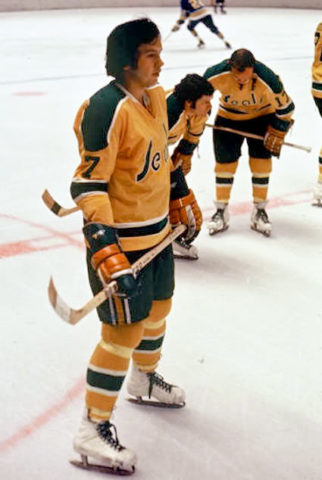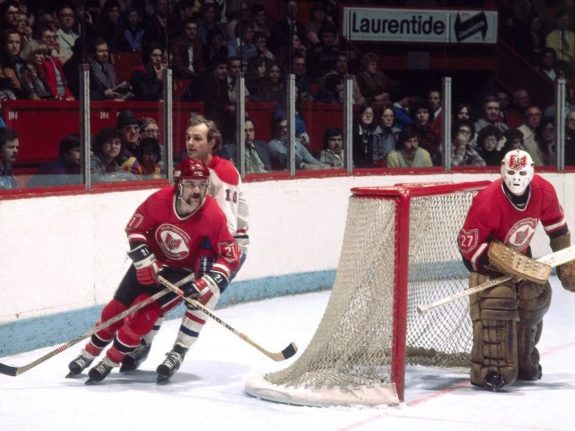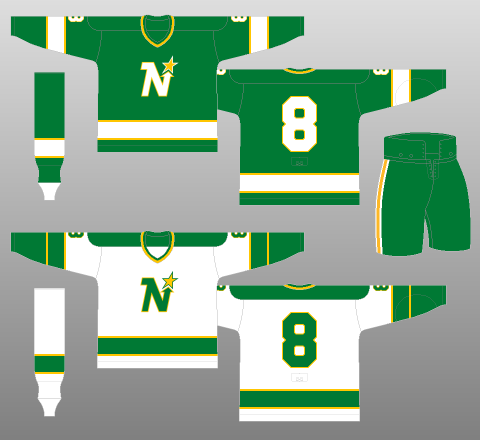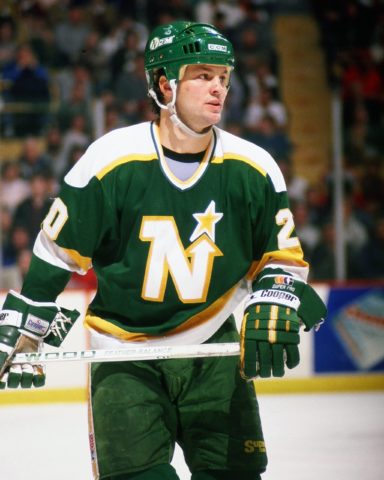Two wrongs don’t usually make a right, but the 1978 merger of the bumbling Cleveland Barons and the struggling Minnesota North Stars proved there are exceptions to the rule.
The path to the NHL’s only amalgamation of two franchises began two years earlier in Oakland, where the Barons existed as the California Golden Seals. By the summer of 1976, the team’s arduous nine-year NHL journey had reached a crossroads. Since inclusion as an expansion franchise in 1967, the sad-sack Seals had endured heavy losses both on and off the ice, making them the perpetual league laughingstock. As the owners realized they could never turn a profit in Oakland, they found one last hope for keeping the team in Northern California: moving across the Bay to downtown San Francisco.
Related: Old School NHL Jerseys – Gone But Not Forgotten
With a brand new arena complex featuring restaurants and retail stores set to be built, the Seals would be able to move in and attract San Franciscans who had been reluctant to travel the 12 miles to Oakland, and who had never identified with the team. When San Fran politicians scuttled plans for the arena, however, the Seals were left with no option but to move someplace entirely outside the Bay area.
Birth of the Barons
Denver became a strong possibility, but minority owner George Gund III suggested that his hometown of Cleveland would be a better choice. The Crusaders of the World Hockey Association were moving out of town, leaving a professional hockey void in the region. There was also a new, state-of-the-art arena in suburban Richfield, Ohio that was ready to welcome a woebegone NHL franchise like the Seals. Majority owner Mel Swig liked the idea, and on July 14, 1976, the NHL made the move official. Shortly thereafter, the California Golden Seals were re-christened the Cleveland Barons. Hopes for a rosy future were high.

“Cleveland could be one of the great hockey cities in the country,” said Swig. “You’re talking about a population of five million people within a 50-mile radius of the Richfield Coliseum…This is the National Hockey League and you’re getting a first-class product,” (from “Cleveland Ends 25-year ‘Wait’ As NHL Approves Shift of Seals,” The Hockey News, August 1976).
During that first season, however, nothing about the Barons’ performance was “first-class.” The locale may have changed, but the roster remained largely the same as the Seals who had finished last in the league the year before: woefully thin on talent and highly inexperienced.
Beyond center Dennis Maruk and right winger Al MacAdam, the Barons’ attack had little firepower. Mike Christie was a bona fide NHL defenseman, but the rest of the blue line looked no older than a group of frat boys heading to a Friday night house party. Aside from 36-year-old Jim Neilson, no D-man was over 26. The Cleveland nets were in solid hands with starter Gilles Meloche and backup Gary “Cobra” Simmons, but with opponents raining rubber on them night after night, enough pucks got by them to help drop the Barons to the depths of the NHL standings. An ugly 11-game winless skid placed them second to last by early December.
Barons on the Edge of Extinction
Few Clevelanders were willing to drive the 40 round-trip miles to the rink in Richfield to see such a pathetic product. Attendance in the 4,000-5,000 range was common, and Swig and his partners were running out of money fast. It was so dire that in February 1977, Swig could not pay his players and asked them to take a 27 percent salary deferment until May. The players accepted through gritted teeth, but when even the reduced paycheques were not forthcoming, they threatened to boycott games until they were paid. With the franchise, again, teetering on the edge of extinction, the NHL, the NHL Players’ Association and Swig put up a combined $1.3 million to see the team through the end of the season.

In the offseason, George Gund and his brother Gordon bought out Swig and assumed full control of the Barons. They declared their commitment to running a tighter financial ship and took measures to help solidify the ground the team skated on, reducing ticket prices and creating a youth hockey program to seed interest in the team and the sport. They talked of building the club into a “championship contender.”
An impressive 4-1 start provided hope, but by season’s end, the Barons sported a sorry 22-45-13 record, landing them again in the Adams Division basement, well outside of the playoffs. Attendances remained low and the overwhelmed Gunds’ financial books were covered in red ink. The brothers wanted out of Cleveland.
Related: All-Time Best Players for Defunct NHL Teams
With no potential buyers on the horizon, Gordon Gund devised the unusual idea of merging with another downtrodden team. The Minnesota North Stars, getting wind of the plan, came forward as willing dance partners. The team had finished dead last in the NHL in 1977-78 and fans were staying away from the Met Center.

Having missed the playoffs in five of the previous six seasons, the Stars, like the Barons, were close to collapse. North Star Financial Corp., a conglomerate of nine men who owned the North Stars from their inception in 1967, couldn’t sign the proposed deal fast enough. The NHL Board of Governors, presented with the chance to rid themselves of the headache that the Seals/Barons franchise had been for 11 years, couldn’t get their pens out of their blazer pockets quick enough either. They happily approved the transaction on June 14, 1978.
The Barons Cease to Exist
Under the terms of the merger, the Cleveland franchise ceased to exist. The Gunds purchased the Stars for about $12 million and assumed their outstanding debts. All but five of the Barons’ players were absorbed by Minnesota, and the combined entity continued to operate as the North Stars.
With essentially two rosters available to create one team, the Stars couldn’t help but improve on the ice. Holdovers from the previous year’s North Stars included centers Tim Young and Glen Sharpley (each had scored over 20 goals), left winger Per-Olov Brasar (20 goals) and D-man Brad Maxwell (18 goals and 47 points). Add up-and-coming talents from the Barons like MacAdam, winger Mike Fidler and center Dave Gardner, along with proven starter Meloche in goal, and the new Minnesota roster was suddenly respectable.
The new North Stars improved by a whopping 23 points in 1978-79 and got even better in 1979-80. Led by emerging star Bobby Smith (their first-overall pick in the 1978 Draft), the Stars finished eight games above .500 and made it to the semifinals, losing out to the Philadelphia Flyers in five games. In the quarterfinals, however, they had succeeded in doing what no team had done in five years: knock the Montreal Canadiens out of the playoffs. They did so with a stunning 3-2 Game 7 win in the Montreal Forum. Ex-Seal MacAdam scored the winner with only 1:26 left to play.
Minnesota Makes its Mark
With the addition of high-scoring rookie Dino Ciccarelli, the Stars kept climbing the following season, defeating the Boston Bruins, Buffalo Sabres and Calgary Flames to make it to the franchise’s first Stanley Cup Final; they lost in five games to the defending champion New York Islanders. Despite the defeat, the North Stars had finally earned the respect of the league.
Related: Canadiens’ Retired Jerseys – the Story of a Famed Franchise
“I’ve been proud of my guys all season long, and I’m proud of them tonight,” said coach Glen Sonmor after the final game.

The Gunds’ unorthodox idea of a merger three years earlier had paid off and more. Although the North Stars rarely shined as bright as they did that spring, and moved to Dallas in 1993, the marriage of two forlorn franchises in 1978 turned the North Stars into a winner and provided Minnesota hockey fans with a host of memories that many still treasure today.